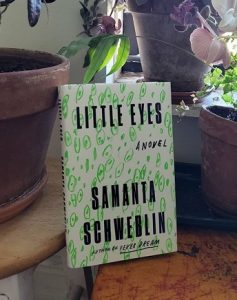Samanta Schweblin’s novel Little Eyes might be the perfect book for our new Quarantine Times. Translated from the Spanish by Megan McDowell, the story feels eerily prescient in the wake of the COVID-19 pandemic. It takes place in a not-so-distant future where people connect virtually through a deceptively simple toy-like device known as a kentuki. Many of the users feel isolated in some way, looking to use this new virtual reality as a means of escape from their actual surroundings. If, like me, you’ve been cooped up for months in light of COVID-19, you might find yourself wishing they were real, if for nothing else but a fun distraction.
But, as the novel progresses and the underlying horrors play out, you’ll be glad this is a work of fiction.
Kentukis are basically stuffed animals that have wheels, allowing them to move around freely; there are various types you can get, like a cute rabbit, a crow, a mole, or a dragon. Inside, there’s a “dweller” who controls the kentuki and sees everything through the animal’s little eyes. If you own a kentuki, you’re known as a “keeper” and typically treat the device as a high-tech pet. Each device has only one life, much like a real pet. It must be charged regularly or the connection is lost. Also, a dweller can disconnect at any time, which leaves the kentuki lifeless, meaning you can’t reboot and try again. Likewise, a keeper can’t disconnect the device and try again if they’re not happy with the dweller for some reason.
Schweblin presents the story through a series of vignettes, each involving different characters from across the globe. Some are dwellers, some are keepers. There are a few characters we return to again and again while others are relegated to only one chapter. The format makes the book highly readable once you get into its flow.
As a dweller, you get to watch someone go about their daily life, often on the opposite side of the world. There are different reasons why some choose to be a dweller as opposed to a keeper, but most jump into the kentuki relationship without thinking about potential consequences – just who is the person behind the little eyes? And how much does the keeper want to know the answer? As with other virtual connections, we often don’t really know what’s on the other end, which adds to the underlying tension through Schweblin’s book.
Some of the kentuki adventures are light and rather harmless – a young boy in Antigua mourning the loss of his mother secretly resides as a dweller inside a dragon much further north; he becomes obsessed with using his dragon to touch snow. An older woman in Peru who misses her son dwells in a cute rabbit kentuki in Germany; she quickly becomes attached to her keeper, but the relationship takes strange turns when the keeper’s lover intrudes.
Perhaps the most interesting keeper/dweller relationship concerns Alina who’s spending time at an artists’ residence in Mexico. Her artist boyfriend is preparing for a show, leaving her alone much of the time. Bored and on a whim, she buys a crow kentuki but remains intent on keeping the relationship as anonymous as possible. She fantasizes about who might be controlling the little crow, but she wants to treat the device as nothing more than a pet. Her behavior towards the kentuki gets stranger and stranger as she feels more and more isolated in the real world. Her story arc carries the novel forward and ends with a disturbing twist.
Little Eyes is perhaps not as creepy as Schweblin’s excellent first novel (to be translated into English) Fever Dream, but it’s just as compelling. I had a hard time putting it down and even had a dream about kentukis one night. I woke up disappointed that they’re not real – but, after shaking off the grogginess, I felt relieved that these strange little creatures don’t exist.
Not yet, anyway.

